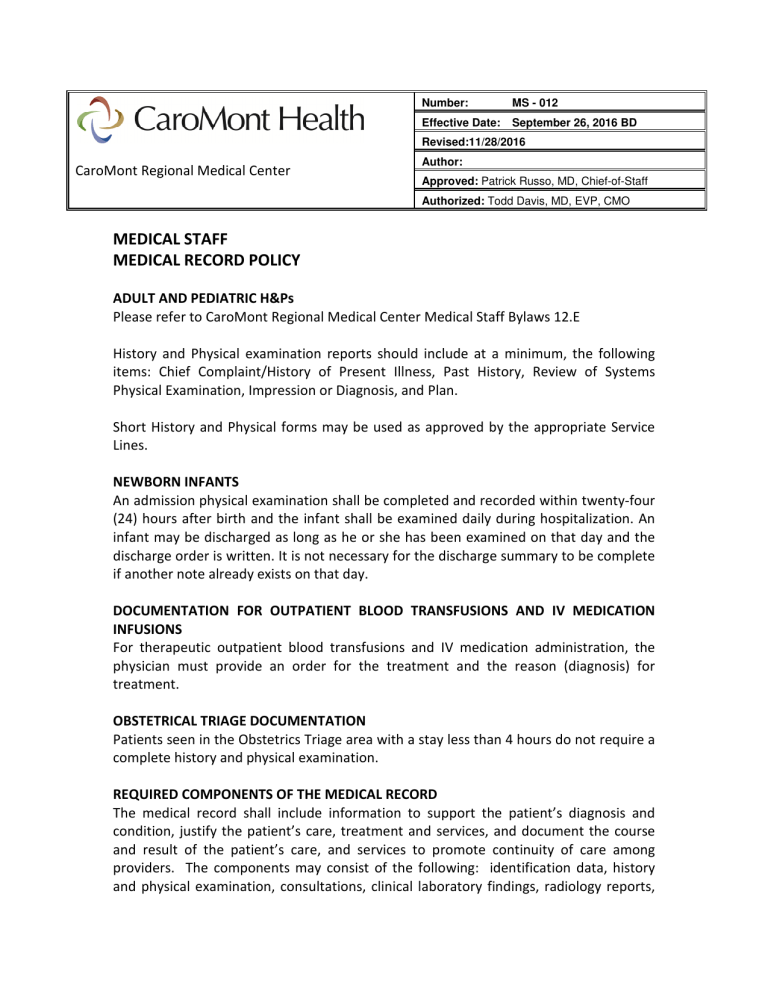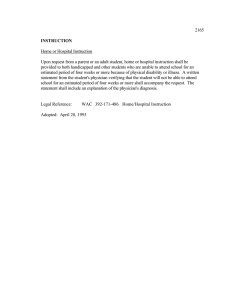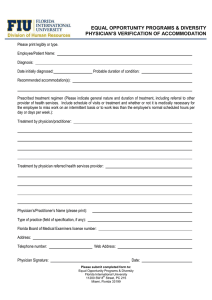
Number: MS - 012 Effective Date: September 26, 2016 BD Revised:11/28/2016 CaroMont Regional Medical Center Author: Approved: Patrick Russo, MD, Chief-of-Staff Authorized: Todd Davis, MD, EVP, CMO MEDICAL STAFF MEDICAL RECORD POLICY ADULT AND PEDIATRIC H&Ps Please refer to CaroMont Regional Medical Center Medical Staff Bylaws 12.E History and Physical examination reports should include at a minimum, the following items: Chief Complaint/History of Present Illness, Past History, Review of Systems Physical Examination, Impression or Diagnosis, and Plan. Short History and Physical forms may be used as approved by the appropriate Service Lines. NEWBORN INFANTS An admission physical examination shall be completed and recorded within twenty-four (24) hours after birth and the infant shall be examined daily during hospitalization. An infant may be discharged as long as he or she has been examined on that day and the discharge order is written. It is not necessary for the discharge summary to be complete if another note already exists on that day. DOCUMENTATION FOR OUTPATIENT BLOOD TRANSFUSIONS AND IV MEDICATION INFUSIONS For therapeutic outpatient blood transfusions and IV medication administration, the physician must provide an order for the treatment and the reason (diagnosis) for treatment. OBSTETRICAL TRIAGE DOCUMENTATION Patients seen in the Obstetrics Triage area with a stay less than 4 hours do not require a complete history and physical examination. REQUIRED COMPONENTS OF THE MEDICAL RECORD The medical record shall include information to support the patient’s diagnosis and condition, justify the patient’s care, treatment and services, and document the course and result of the patient’s care, and services to promote continuity of care among providers. The components may consist of the following: identification data, history and physical examination, consultations, clinical laboratory findings, radiology reports, Medical Staff Medical Record Policy Page 2 of 7 procedure and anesthesia consents, medical or surgical treatment, operative report, pathological finings, progress notes, final diagnoses, condition on discharge, autopsy report when performed, other pertinent information and discharge summary. DISCHARGE DOCUMENTATION The medical record contains a concise discharge summary that includes the following: 1. Reason for hospitalization 2. Procedures performed 3. Care, treatment and services provided 4. Patient’s condition at discharge 5. Information provided to the patient and family 6. Provisions for followup care. 7. Patients who are discharged alive following a hospitalization for a period of less than forty-eight (48) hours on a non-intensive care unit may have a final progress note substituted for a discharge summary provided the note contains the outcome of the hospitalization, disposition of the case, and provisions for follow-up care. For uncomplicated obstetrical cases, including Cesarean section deliveries, the OB Summary Form approved by the Women’s Service Line and Executive Committee will be acceptable as a discharge summary. No discharge summary will be required on normal newborns. ORDER ENTRY AND REQUIREMENTS All orders for treatment and diagnosis shall be entered by computerized physician order entry (CPOE) or in writing. Orders shall include those provided by medical and dental staff members and by other practitioners within the authority of their clinical privileges. VERBAL ORDERS Verbal orders shall be signed by the appropriately authorized person to whom dictated with the name of the responsible practitioner (and also of the Privileged Practitioner member for whom such practitioner is responsible if dictated by such Privileged Practitioner per his or her own name) and shall be recorded with “read back” verification. Generic and trade names of drugs may not be abbreviated. 1. Verbal orders must be authenticated by the practitioner who gave the order within seven (7) days of giving the verbal order. Verbal orders may be authenticated by a practitioner within the same group practice. 2. Verbal orders may be taken by RNs and LPNs. Verbal orders for Imaging Services may be taken by graduate or Registered Radiologic Technologists, Nuclear Medicine Technologists, or Ultrasound Technologists. Verbal orders related to rehabilitation services may be taken by a licensed physical therapist, licensed Medical Staff Medical Record Policy Page 3 of 7 occupational therapist, and/or licensed speech therapist. Verbal orders for echocardiographic may be taken by registered echocardiography sonographers. 3. Verbal orders for diets and/or diet instruction may be taken by registered dietitians, dietetic technicians, dietetic interns (under registered dietitian supervision), or dietitians pursuing registration by exam. Verbal orders for respiratory therapy services may be taken by a graduate Respiratory Therapist or a Registered Respiratory Therapist. Verbal orders relating to drug therapy may be taken by a registered pharmacist, pharmacy students under the direct supervision of a registered pharmacist, or pharmacists pursuing registration by exam or reciprocity. PRE-PROCEDURAL DOCUMENTATION Prior to operative and other invasive procedures appropriate laboratory studies will be recorded in the patient's medical record. Laboratory studies should have been performed no more than ninety (90) days prior to procedure based on the complexity and stability of the patient’s medical condition. Pertinent data used from outside sources must be documented in the patient's medical record. 1. For a history and physical examination that was completed within 30 days prior to registration, an update documenting examination of the patient and any changes in the patient’s condition must be completed within 24 hours after registration for a medical admission, but prior to an operative or other high-risk procedure requiring moderate or deep sedation or anesthesia. Unchanged status must be documented through a note in the medical record such as, “Patient Examined and No Changes – Updated (date time/sign)” 2. Prior to operative and other high-risk procedures a preoperative diagnosis shall be recorded by the practitioner performing the procedure. In an emergency surgical situation, when there is no time to record the complete history and physical examination, the physician shall record the preoperative diagnosis before surgery. For Consent requirements please refer to the CaroMont Health Consent Policy POST-PROCEDURAL DOCUMENTATION An operative or other high-risk procedure report is written or dictated immediately upon completion of the operative or other high-risk procedure and before the patient is transferred to the next level of care. If a progress note is written immediately after the procedure, the full report can be written or dictated within 24 hours. If the practitioner performing the procedure accompanies the patient from the operating room to the next unit or area of care, the report can be written or dictated in the new unit or area of care. Medical Staff Medical Record Policy Page 4 of 7 The full operative report includes the following information: 1. Name(s) of licensed independent practitioner(s) who performed the procedure and his or her assistant(s) 2. Name of the procedure 3. Description of the procedure 4. Findings of the procedure 5. Estimated blood loss 6. Specimen(s) removed 7. Postoperative diagnosis When a progress note is entered in the medical record before the patient is transferred to the next level of care, the note includes the following information: 8. Name(s) of the primary surgeon(s) and his or her assistants 9. Procedure performed 10. Findings of the procedure 11. Estimated blood loss 12. Specimens removed 13. Postoperative diagnosis POST-OPERATIVE ORDERS All previous orders, unless otherwise specified, are canceled when post-operative orders are written. PROGRESS NOTES Unless circumstances dictate otherwise, it is expected that pertinent progress notes should be recorded at the time of observation, sufficient to permit continuity of care and transferability at least daily by the attending or his/her designee. Entries in the medical record are authenticated by the author, either by electronic signature, written signature or initials, or computer key. Handwritten entries shall be legible, dated, timed, and authenticated. Use of stamped signatures are not acceptable to establish authentication. SYMBOLS AND ABBREVIATIONS Symbols and abbreviations may be used only when they have been approved by the Medical Staff. An official record of approved abbreviations shall be maintained in the CaroMont Health Administrative Manual. RELEASE OF INFORMATION Written consent of the patient is required for release of medical information to persons not otherwise authorized to receive this information. Please refer to the CaroMont Health HIPAA Policies for further information and guidance. Medical Staff Medical Record Policy Page 5 of 7 MEDICAL RECORD ACCESS Members of the Medical Staff may have access to medical records of all patients to whom they have provided medical care. Access by Medical Staff members to medical records for study and research shall be approved by the Executive Committee of the Medical Staff and the Institutional Review Board before records can be studied. Research and study reports created as a result of this type of record review must preserve the confidentiality of the protected health information of individual patients. COMPLETION OF MEDICAL RECORDS A medical record shall not be permanently filed until it is completed by the responsible practitioner or is ordered filed by the Chief of Staff. Physicians shall complete medical records in a timely manner. The Medical Record Department will monitor the completion of records by counting incomplete records that are greater than 30 days from discharge on each Thursday afternoon at 1:00 p.m. These records will be delinquent and physicians responsible for completion of these records will be listed on a Delinquent Record List. DELINQUENT COMPLETION OF MEDICAL RECORDS Physicians will be responsible for knowing when charts are due by logging into the electronic medical record system to determine if there are charts to be completed. When a physician is listed on the Delinquent Record List, the Medical Record Department will place this list in his/her mailbox in the Physician Lounge on the afternoon the list was created. If a physician is listed on the Delinquent Record List two (2) consecutive weeks that physician will be listed on a Suspension List. If a physician is on the Delinquent Record List twelve (12) times during a calendar year, that physician will be listed on a Suspension List each time his name is on the Delinquent Record List for the remainder of that calendar year. 1. When a physician has been listed on a Suspension List, all privileges are terminated until his records have been completed. Suspended privileges includes the scheduling of and privileges for inpatient admissions, admissions for observation, ambulatory or outpatient procedure admissions such as surgery, endoscopy, radiologic procedures, cardiac catheterization, stress testing, echocardiography, and EKG interpretation, whether they were scheduled, routine or emergent. If a physician's privileges have been suspended, and he has scheduled admissions either he must complete his records thus removing himself from this list or prior arrangements must be made to defer these admissions until his records have been completed. Those physicians will be Medical Staff Medical Record Policy Page 6 of 7 brought to the attention of the Board of Directors. When a physician is suspended, a letter signed by the Chief-of-Staff will be faxed and/or emailed to the physician’s office on the afternoon the suspension takes place. If a physician is away from his practice five (5) or more consecutive days he will not be listed on the Delinquent Record List provided he has contacted the Medical Record Department prior to his time away, and he has completed all records available to him prior to the time of his leave. The Delinquent Record List will not be published on weeks during which the following holidays occur: New Years, Easter, Thanksgiving, and Christmas. 1. The Delinquent Medical Record List will be distributed to the Medical Directors, Service Line Physician Administrators, Chief Executive Officer, Chief of Staff, Chief Operating Officer, Chief Medical Officer and each physician on the list. The Suspension List will be distributed to the same individuals. The list will also be made available to the ED, Admitting office, Medical Staff Office, OR and scheduling. PERSONNEL PERMITTED TO MAKE MEDICAL RECORD ENTRIES The following categories of health care personnel may record appropriate reports, progress notes, or observations in the established manner in the patient's medical record: licensed practical nurses, registered nurses, nurse anesthetists, pharmacists, pharmacy students (under pharmacist's supervision), audiologists, speech therapists, respiratory therapists, clinical psychologists, social workers, social work assistants, registered dietitians, dietary technicians, dietary interns (under registered dietitians supervision) or dietitians pursuing registration by exam, physical, occupational and activity therapists, licensed physical and occupational therapy assistants, rehabilitation technicians, school teacher, substance abuse counselor, chaplains, radiologic technologists, ultrasound technologists and nuclear medicine technologists. Nursing assistants, nursing psychiatric and emergency services technicians may chart results of their assigned activities on flow sheets and nursing notes, primarily completing blanks on checklists, excluding narrative charting in the nurses notes. Any student or clinical instructor from an education institution that has a contract with the hospital to provide a site for clinical experience may chart in the medical record according to their respective discipline's guidelines. PHYSICIAN CO-SIGNATURES A physician must co-sign the following medical record entries if made by an advanced care practitioner: 1. History and Physicals 2. Operative/Procedure Reports 3. Discharge Summary 4. Consultant Note for an initial assessment Medical Staff Medical Record Policy Page 7 of 7 5. Admission Order for inpatient status. PRONOUNCEMENT OF DEATH When a patient expires, a physician or advanced care practitioner has the responsibility to declare death within a reasonable time. If a physician or advanced care practitioner is unavailable to pronounce, the Nursing Shift Manager, Director or clinical support staff may provide declaration except when: 1. The death is an unexpected outcome 2. The patient has been designated as a full Code Blue status 3. The patient is on a ventilator 4. The patient is a coroner’s case 5. There is potential for family concerns or controversy that would need physician explanation or intervention. EMERGENCY RECORD DOCUMENTATION An appropriate medical record shall be kept for every patient receiving emergency service and be incorporated in the CRMC’s electronic medical record system. The record shall include: 1. Adequate patient identification 2. Information concerning the time of the patient's arrival, means of arrival and by whom transported 3. Pertinent history of the injury or illness including details relative to first aid or emergency care given to the patient prior to his arrival at the hospital 4. Vital signs 5. Description of significant clinical, laboratory and radiologic findings 6. Diagnosis 7. Treatment given 8. Condition of the patient on discharge or transfer 9. Time of discharge or transfer Approved Revision: 11/28/2016 BOD



